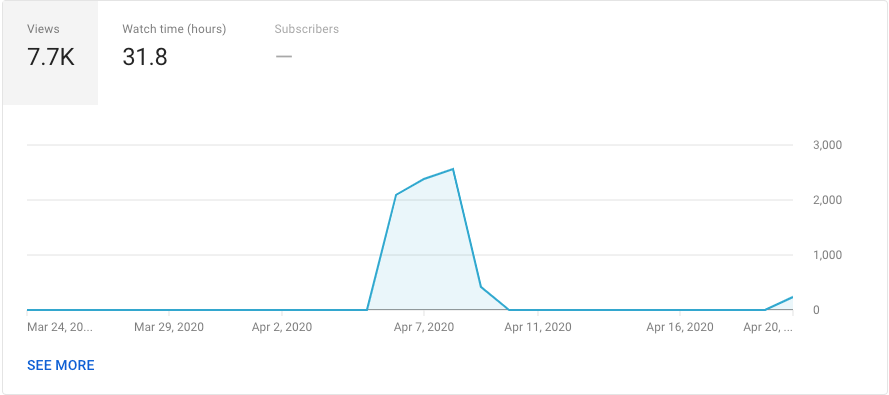
Measuring metrics is an essential part of any successful B2B SaaS strategy. Tracking and analyzing data puts you in the driving seat when it comes to making business decisions. You’re basing the future direction of your company on fact rather than fiction.
Every operator worth their salt knows that key B2B SaaS metrics include MRR, churn, LTV, and CAC. But what about measuring the success of your video marketing campaigns? Video hosting sites such as YouTube, Wistia, and Facebook allow you to view video analytics, but it can be daunting to understand which ones deserve the most attention.
We’ve shortlisted six key B2B video metrics that will help you analyze the success of your video campaigns and understand if your video marketing strategy is generating a positive ROI for your business.
1. Play Rate
Video play rate is the number of times a viewer saw your video and clicked play. Expressed as a percentage, play rate is a reliable indicator of how appealing your video is to watch. If your play rate is low, your audience sees your video but doesn’t click play. This signals a massive opportunity to test your video placement (if it’s on a landing page), the social channels you’re posting on, and whether or not your video’s presentation is alluring enough for your visitors to want to hit play.
Most video hosting platforms, for example, YouTube or Wistia, will give you data that allows you to measure play rate. Each industry will have different benchmarks as to what a reasonable play rate is, however, research by Data Box found that the average play rate lies between 41-60%.
2. Video Engagement
Probably the most crucial B2B video metric you’ll want to keep an eye on is video engagement. This metric shows how much of your video a viewer watched. Also expressed as a percentage, video engagement is imperative to measure to understand the quality of your video.
Most of the significant video channels will show video engagement as a graph. Analyzing this data will enable you to uncover whether your viewers are watching your video to the end, whether they stopped halfway through, or skipped ahead to specific sections.
When you measure video engagement, one key factor to keep in mind is the higher the level of video engagement, the more effective your video is. One of the easiest ways to measure video engagement is through quarterly tracking. This means you’ll analyze and measure which views got to 25%, 50%, 75%, and 100% of your video. If your audience is reaching 100%, well done, this shows that your audience is fully engaged and retains their interest throughout the video.
Anything less than 100% is an indicator that you need to improve certain parts of your video. For example, the majority of viewers drop off at the 50% mark. This could be that they’ve seen the information they were looking for and decided to click away. If your CTA is at the end of your video this would also mean that your audience is leaving before they’ve had a chance to take the desired action. One solution to solving video engagement is to keep videos short, concise, and to the point.
3. Watch Time
Watch time is an indicator of whether your audience is watching the length of your video. Ideally, you’ll want to see a high watch time from your B2B video marketing efforts because this will show that your audience is watching your videos (duh). Watch time is also an indicator of whether your video’s content and message are keeping your audience engaged. On YouTube, watch time is measured by multiplying views by average view duration.

More importantly, watch time is an opportunity to uncover problems with your video marketing. For example, if you have a one-minute video and your average watch time is 20 seconds, this signals that viewers are disengaging with your content around that mark. Analyze why this might be. Do you switch topics at this point? Or do you say something that could be deemed controversial? Measuring watch time will help you to uncover the flaws in your video marketing campaigns.
4. Social Media Engagement
Measuring engagement shows you how well your target audience is receiving your video. Social media engagement is also indicative of the quality of your video.
Engagement nowadays can take on many different forms, including likes, reactions, shares, and comments. Engagement on social media can have a bad reputation and is sometimes labelled a “vanity metric” due to its flimsy stance on driving revenue. However, engagement is about measuring qualitative data such as emotion and feeling — both important factors in understanding your audience.
Social Shares
Social shares are the frequency that your video is shared on social media. The more social shares that your B2B video has, the more you’re continuing to raise your brand awareness. This metric is relative to impressions, though. For example, a video with 20M impressions and 1,000 shares will be doing worse than videos with 1M impressions and 500 shares. Social shares should always be looked at as a ratio because impressions directly impact shares.
Social shares are also an indicator of resonance and credibility. Audiences tend to share content that resonates with them and that they deem a credible source of information.
Comments
Comments and feedback provide you with evidence as to how your audience is receiving your video. Positive comments will show that your video has landed well, along with comments asking questions. Comments that are veer toward being negative will confirm that your video hasn’t quite hit the right note.
Likes and Reactions
People react to social media posts when they feel an emotion. On Facebook, you can respond to a post with an emoji that’s funny, sad, loveable, surprised, or angry, along with being able to “like” the post. On other social media platforms, only likes are more common-place. Both reactions and likes show you the feeling that’s associated with your video. Analyzing this data will show you how your marketing video made your audience feel.
5. Click-through Rate
Click-through rate (CTR) measures how successful your video is at driving your audience to take action. Most B2B SaaS videos will include a call to action (CTA) — a button or clickable link that takes the viewer to the next stage of their purchase journey. A good CTA could encourage the viewer to sign up to a company newsletter, subscribe to your video channel, or even buy a product or service.
It’s advisable to generate a decent amount of impressions before analyzing your click-through rate. Doing so will allow you to see a more accurate picture of how your video is truly performing. This means that click-through rate is a metric that varies for everyone. However, YouTube has stated that “half of all channels and videos on YouTube have an impressions click-through rate that can range between 2% and 10%”.
By measuring, analyzing, and improving your click-through rate, you’ll likely see an increase in leads, traffic, sales, and revenue as more people take the action you need to enter the marketing funnel.
6. Conversion Rate
Video conversion rate will show you the success that your video has in turning viewers into leads or customers. Analyzing this metric will give you a clear understanding of how successful video marketing is contributing to your bottom line. Measuring conversion rate from video does require some additional heavy lifting, as you’ll need to set up tracking via Google Analytics and clarify precisely what your attribution model is for conversions.
Conversion rates differ depending on traffic quality, industry, and what you’re selling. There’s no one-size-fits-all solution for measuring conversion rate—every business will be different. If you’re after a ballpark figure, our friends over at Unbounce shared that “a 12% conversion rate is pretty good for lead generation landing pages”. That’s not taking into account landing pages that contain video, which can boost conversions by 34%.
Whether you’re brand new to creating video content or a seasoned veteran, measure the metrics that matter, and watch your B2B SaaS company generate more leads, more growth, and more revenue by harnessing the power of video marketing and video analytics.
Ready to create B2B marketing videos? Lumen5’s A.I. powered technology saves your time and resources. Sign up today and start creating sharable, snackable video content in minutes.






